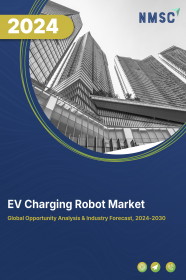
EV Charging Robot Market by Mode of charging (Plug-in charging and Wireless charging), by Connector Type (CHAdeMO, Combined Charging System, and Others), and by Application (Residential, Commercial, and Industrial)- Global Opportunity Analysis and Industry Forecast 2024-2030
Market Definition
The EV Charging Robot Market size was valued at USD XXX billion in 2023 and is predicted to reach USD XXX billion by 2030 with a CAGR of XX% from 2024-2030.
EV charging robot are autonomous robot designed to charge electric vehicles automatically without human intervention. They are innovative systems that provide a hands-free, automated way to charge EVs. These robots use advanced technologies such as sensors, algorithms, and control systems and are equipped with a robotic arm that can locate and connect the charging plug to the EV’s charging port.
The robot can also monitor and control the charging process, ensuring that the vehicle is charged safely and efficiently. The use of charging robot eliminates the need for human intervention during the charging process, providing greater convenience and safety. They can also be integrated with the charging station's management system, which can provide real-time updates on the charging status of each vehicle. This can help the charging station operator to manage their operations more effectively and reduce the risk of overloading the electrical grid.
Market Dynamics and Trends
The increasing adoption of electric vehicles is driving the growth of the EV charging robot market. As per the latest report published from the International Energy Agency, the demand for EVs and PhEVs is growing significantly across the globe, with more than 10 million vehicles sold in 2022. As more people switch to EVs, the demand for convenient and efficient charging solutions is on the rise, boosting the growth of the market.
Moreover, technological advancements, including the emergence of autonomous charging robots and wireless charging technology, are anticipated to significantly enhance the growth of the market. These innovations offer faster, more efficient, and convenient charging solutions for electric vehicles (EVs). Autonomous charging robots enable seamless and automated charging processes, eliminating the need for human intervention and enhancing overall efficiency.
Additionally, wireless charging technology enables EVs to be charged without the use of cables or plugs, providing greater convenience and flexibility for users. These advancements in charging technology not only streamline the charging process but also contribute to the broader adoption of electric vehicles, driving further growth in the market.
Furthermore, the increasing environmental awareness and greenhouse emissions coupled with favorable government policies to promote the sale of EVs and the installation of charging stations to reduce carbon footprints are further accelerating the growth of the market. For instance, in November 2022, the Oregon Department of Environmental Quality invested USD 6.8 million for the expansion and installation of EV charging stations at 64 sites across North Carolina. The investment was aimed to reduce carbon footprint and air pollution.
However, the high cost of implementation and maintenance of EV charging robot along with the risk of malfunction or technical issues are the major factors restraining the growth of the market. On the contrary, the increasing autonomy and intelligence in charging robot and their integration with power grids and other technologies such as 5G networks and IoT are expected to create ample opportunities for EV charging robot market in the coming years. These advancements is anticipated to provide EV robot autonomously connect, monitor, and control the charging process, allowing for more efficient use of electricity and reducing strain on the power grid.
Market Segmentations and Scope of the Study
The EV charging robot market share is segmented on the basis of type, mode of charging, connector type, application, and end user. On the basis of mode of charging, the market is classified into plug-in charging and wireless charging. On the basis of connector type, the market is segmented into CHAdeMO, combined charging system, and others. On the basis of application, the market is divided into residential, commercial, and industrial. Regional breakdown and analysis of each of the aforesaid segments include regions comprising of North America, Europe, Asia-Pacific, and RoW.
Geographical Analysis
North America holds the dominant share of EV charging robot market and is expected to continue its dominance during the forecast period. This is due to the growing adoption of electric vehicles in countries such as the U.S. and Canada.
With the rapidly growing adoption of EVs in these countries, the demand for efficient and convenient charging is also growing, thereby driving the growth of the EV charging robot market. According to the Electric Autonomy Canada, the demand for battery electric vehicles and plug-in hybrids increased from 6.2% in 2021 to 7.7% in 2022.
Moreover, the increasing investment in electric vehicle (EV) charging infrastructure by private companies such as ADS-TEC and Tesla Inc. in this region is playing a significant role in driving market growth. For instance, in December 2022, ADS-TEC Energy announced the opening of its first specialized fast-charging manufacturing facility in North America, expanding the availability of fast-charging options for EV owners in the region.
Similarly, companies such as Tesla Inc. are actively investing in EV charging infrastructure to support the growing demand for electric vehicles. These strategic investments contribute to the development of a robust and accessible charging network, thereby encouraging the adoption of EVs and further propelling market growth.
On the other hand, Asia Pacific is expected to show a steady growth in the EV charging robot market. This is due to the rapid growth of electric vehicle (EV) manufacturing industries in the Asia Pacific region is driving demand for EV charging robot to automate the charging process and increase efficiency.
According to the China Association of Automobile Manufacturers (CAAM), sales of battery electric vehicles (BEV) and plug-in hybrids (PHEV) amounted to 5.3 million and 1.5 million respectively in 2022. As more EVs are manufactured and sold in the region, the need for smart and convenient charging solutions and charging infrastructure also increases, leading to growth in the EV charging robot market.
Moreover, the growing emphasis on reducing carbon emissions and advocating for sustainable energy solutions has spurred a surge in the adoption of electric vehicles (EVs) across the Asia Pacific region. This includes the utilization of innovative technologies such as EV charging robots, which offer automated and streamlined charging processes for EV owners. As governments, businesses, and individuals strive to transition towards cleaner transportation alternatives, the demand for EV charging infrastructure and solutions continues to rise, driving further innovation and development in the sector.
Competitive Landscape
Various market players operating in the EV charging robot market include ChargePoint Inc., ABB Ltd., Volkswagen's, Siemens AG, Rocsys, Tesla Inc., Eaton Corporation , ADS-TEC, Cyber Switching Patents LLC, TGOOD Global Ltd. and others. These market players are adopting various strategies such as collaborations and product launches to remain dominant in the EV charging robotics market.
For instance, in December 2022, Charging Robotics Ltd collaborated with Make My Day, a company that develops apps and services for electric vehicles, announced the launch of a robotic EV charging station pilot in 2023. The new robot can accept charging service requests in advance, receive information about billing, review driving directions, and analysis real-time data about the EV’s battery status.
Moreover, in June 2022, EV Safe Charge launched its robotic EV charging mobile robot named Ziggy. The new robot can charge EVs anywhere it is parked and uses different energy sources to charge itself. Furthermore, in January 2022, Continental AG collaborated with Volterio GmbH to develop fully automatic charging robot for electric vehicles. The charging robot can charge EVs autonomously without the need for human intervention.
Key Benefits
-
The report provides quantitative analysis and estimations of the EV charging robot market from 2024 to 2030, which assists in identifying the prevailing market opportunities.
-
The study comprises a deep-dive analysis of the EV charging robot market including the current and future trends to depict prevalent investment pockets in the market.
-
Information related to key drivers, restraints, and opportunities and their impact on the EV charging robot market is provided in the report.
-
Competitive analysis of the players, along with their market share is provided in the report.
-
SWOT analysis and Porters Five Forces model is elaborated in the study.
-
Value chain analysis in the market study provides a clear picture of roles of stakeholders.
Key Market Segments
By Mode of Charging
-
Plug-in charging
-
Wireless charging
By Connector Type
-
CHAdeMO
-
Combined Charging System
-
Others
By Application
-
Residential
-
Commercial
-
Industrial
By Region
-
North America
-
U.S
-
Canada
-
Mexico
-
-
Europe
-
UK
-
Germany
-
France
-
Italy
-
Spain
-
Denmark
-
Netherlands
-
Finland
-
Sweden
-
Norway
-
Russia
-
Rest of Europe
-
-
Asia-Pacific
-
China
-
Japan
-
India
-
South Korea
-
Australia
-
Indonesia
-
Singapore
-
Taiwan
-
Thailand
-
Rest of Asia-Pacific
-
-
RoW
-
Latin America
-
Middle East
-
Africa
-
REPORT SCOPE AND SEGMENTATION:
|
Parameters |
Details |
|
Market Size in 2023 |
USD XXX billion |
|
Revenue Forecast in 2030 |
USD XXX billion |
|
Growth Rate |
CAGR of XX% from 2024 to 2030 |
|
Analysis Period |
2023–2030 |
|
Base Year Considered |
2023 |
|
Forecast Period |
2024–2030 |
|
Market Size Estimation |
Billion (USD) |
|
Growth Factors |
|
|
Countries Covered |
28 |
|
Companies Profiled |
10 |
|
Market Share |
Available for 10 companies |
|
Customization Scope |
Free customization (equivalent up to 80 working hours of analysts) after purchase. Addition or alteration to country, regional, and segment scope. |
|
Pricing and Purchase Options |
Avail customized purchase options to meet your exact research needs. |
KEY PLAYERS
-
ChargePoint Inc.
-
ABB Ltd.
-
Volkswagen's
-
Siemens AG
-
Rocsys
-
Tesla Inc.
-
Eaton Corporation
-
ADS-TEC
-
Cyber Switching Patents LLC
-
TGOOD Global Ltd.

















 Speak to Our Analyst
Speak to Our Analyst





















